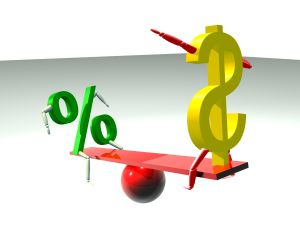
A couple of days ago I posted an article suggesting that Australia needed to have a bit more of a mature conversation about the structure of our economy in order to set the agenda for the future. The article had a very good response and, as usual, started some intelligent dialog in the MacroBusiness community.
Given that interest I thought I would spend some time looking at some details in the balance of payments data from the ABS in order to provide a more informed background to what we are seeing in the economy. There is a lot to go through and many concepts to discuss so this will be a multi-part post, with half today and half on Monday.
As you may know I tend to describe the economy in 3 parts, the government sector , external sector and the private sector. The reason I do this is because it fits with the national accounts data and the national accounting identity of sectoral balance.
For those who aren’t sure about the sectoral balance equation you can read this article, but the basic premise is that there is an accounting rule flowing for the calculation of national GDP that states that there is a direct and unbreakable relationship between the government budget balance (deficit/surplus), the external sector balance ( current account ) and the private sector (businesses and households) budget balance over an accounting period.
For reference here is the Australian government sector balance as a proportion GDP since 1979 through early 2011:
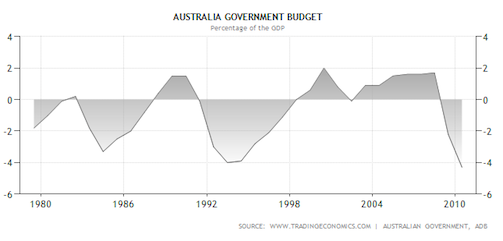
The balance of payments data is basically a balance sheet of our nation’s net borrowing or supply, in dollar terms of goods, services and financial assets, to/from the rest of world. The major component of the balance of payments is the current account:
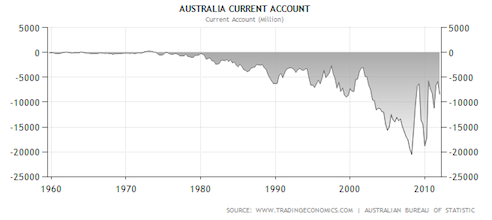
You can see Australia began making net payments to the world sometime around 1974 and has never looked back. Even the recent surge in Australia’s terms of trade stemming from the mining boom hasn’t been enough to get the account into the black.
So how can this be ? Well we need to dig a little deeper into the data to get the details.
The balance of payments is made up of three accounts. The Current Account, the Capital account and the Financial account.
a ) Current account
According to the ABS
Transactions between Australia and the rest of the world in goods, services, primary income, and secondary income are recorded in this account. It is distinguished from the capital and financial accounts.
The current account shows the net amount a country is earning if it is in surplus, or spending if it is in deficit, and it is called the “current” account because it covers financial transactions occurring “right now”, meaning these transactions don’t give rise to future claims.
The current account is broken down further into the balance of trade in goods and services, primary income and secondary income. You can see the breakdown of the account from the summary section of the latest balance of payments.
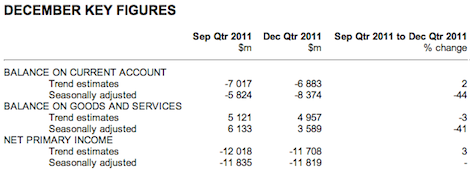
Balance of trade is self explanatory, while Primary income:
The primary income account shows primary income flows between resident and non-resident institutional units. The international accounts distinguish the following types of primary income:
- compensation of employees;
- dividends;
- reinvested earnings;
- interest;
- investment income attributable to policy holders in insurance, standardized guarantees, and pension funds;
- rent;
- and taxes and subsidies on products and production.
and Secondary income.
Secondary income include current transfers that offsets to the provision of resources that are normally consumed within a short period (less than twelve months) after the transfer is made. Examples include food aid, remittances from residents temporarily abroad, and remuneration received by international students undertaking university studies.
b) Capital account
This is usually a very small component of the balance of payments as it records both acquisitions and disposals of non-produced, non-financial assets and capital transfers. This includes things such as patents, leases and licenses for use of products, but not the actual value of any actual products themselves.
c) Financial Account
According to the ABS
This account records all transactions between residents and non-residents, associated with a change of ownership of foreign financial assets and liabilities during the period including the creation and liquidation of financial claims.
This account is further broken down into:
- Direct investment
- Reserve assets
- Portfolio
- Financial derivatives
- Other investment
So basically, when the external sector is in deficit the current account and capital accounts tell us how we are spending the money and the financial account tells us how we are funding the bill. The equation is
Current account + Capital account = Financial account
Which is why it is called the “balance of payments”.
So now you have the background let’s have a look at the data. If you have a look at the current account breakdown it is easy to see that the terms of trade are having a positive influence on the account. That is, in dollar terms, we are exporting more goods and services than we are importing.
However, what you will also notice is that our primary income is negative and of a greater magnitude than our balance of trade is positive. In other words, even though we are in the midst of a commodities boom money is still flowing out of the local economy via the external sector:
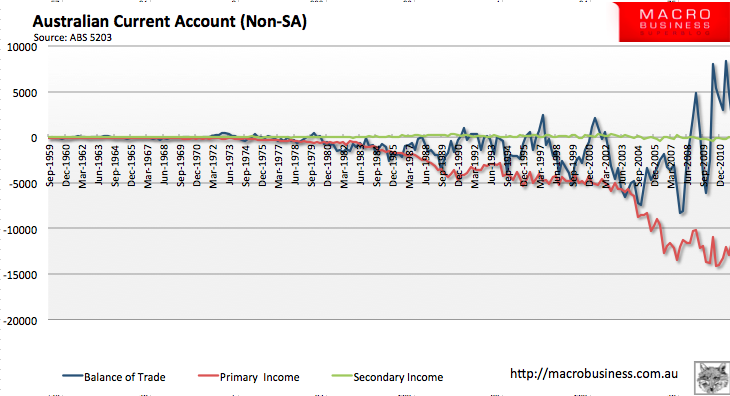
So where is it all going ? Well if we breakdown primary income into its component parts we get the result below. This tells us that the major components of our primary income deficit are from direct investment income and portfolio interest payments to the rest of the world:
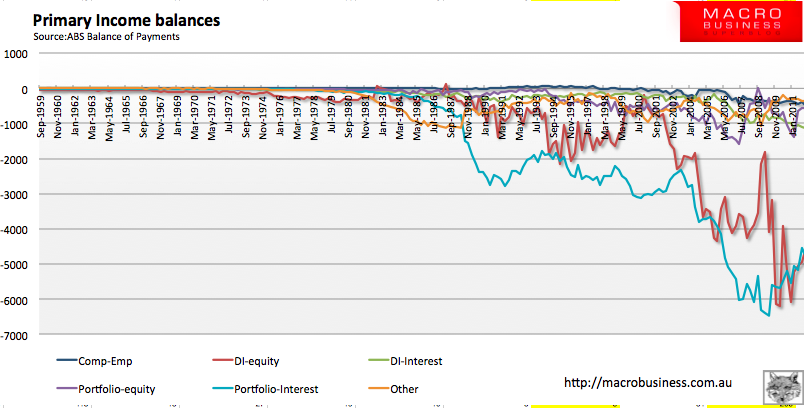
Which basically means that in aggregate Australia sends massive amounts of dividends and interest payments to the rest of the world. In fact it is so large that it is dwarves our trade in goods and services, resulting in a net loss to the external sector even during the historically high terms of trade. The most important thing to note is that these are payments stemming from previous foreign investments meaning Australia is continuously making payments to rest of the world somewhat independently of the balance of trade.
Finally, the financial account tells us that in order to maintain this current account deficit, Australia continually relies on foreign direct investment capital flows along with sales of equities:
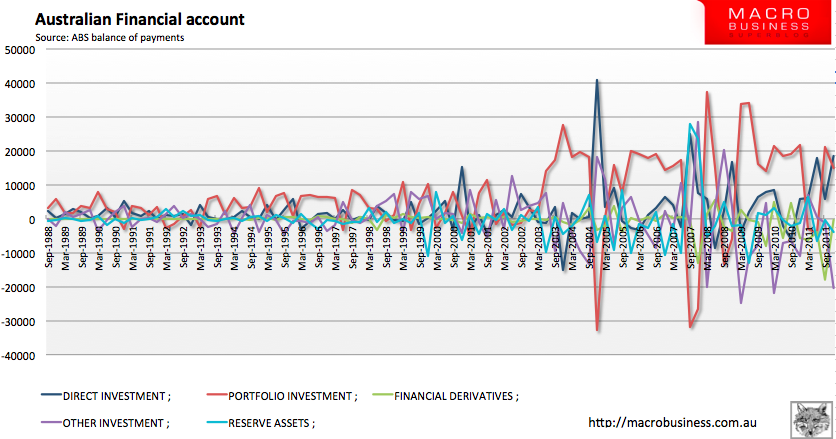
The latest statement of the financial account gives a fairly good example of how we are footing the bill for the capital outflows.
The balance on financial account, in original terms, recorded a net inflow of $9.2b, with a net inflow of $11.6b of equity and a net outflow of $2.4b of debt.
The financial account surplus increased $1.4b, from $7.7b in September quarter 2011 to $9.2b in December quarter 2011.
Direct investment recorded a net inflow of $18.5b in December quarter 2011, an increase of $12.7b from the net inflow of $5.9b in September quarter 2011, where:
– direct investment liabilities recorded an inflow of $23.9b, an increase of $4.4b on the inflow of $19.6 in September quarter 2011
– direct investment assets recorded an outflow of $5.4b, a decrease of $8.3b on the outflow of $13.7b in September quarter 2011.
Portfolio investment recorded a net inflow of $15.0b, a decrease of $6.3b on the net inflow of $21.3b in September quarter 2011, where:
– equity and investment fund shares recorded a net outflow of $5.6b
– debt securities recorded a net inflow of $20.6b,
where portfolio investment liabilities, debt securities increased $1.2b from $18.8b of issues in September quarter 2011.
Financial derivatives recorded a net outflow of $0.2b, a decrease of $17.7b from the net outflow of $17.9b in September quarter 2011.
Other investment recorded a net outflow of $20.4b, an increase of $19.3b from the net outflow of $1.2b in September quarter 2011.
Reserve assets recorded a net outflow of $3.7b, an increase of $3.4b from the net outflow of $0.3b in September quarter 2011.
So in other words we sold lots of new financial assets to foreigners so we could pay them the interest we owed them stemming from their previous purchases. Sounds a little ponzi-ish doesn’t it? But let’s not get ahead of ourselves.
I think that is enough for today, there is already a lot to digest and I think it is important to truly understand the structure of the external account before moving on. I also think it is important that we continue to have adult conversations about the structure of the economy, so on Monday I’ll put together another post explaining the implications of all of this, including the flow-on effects and relationships with the other sectors of the economy.